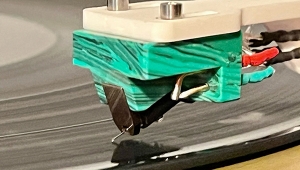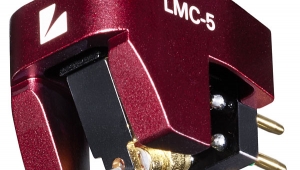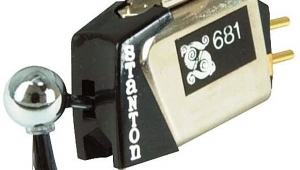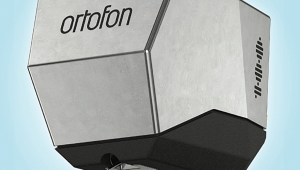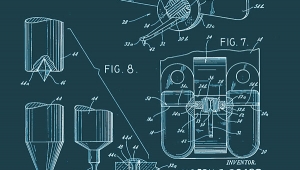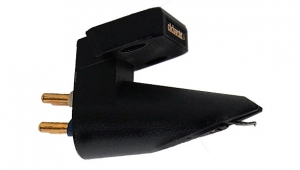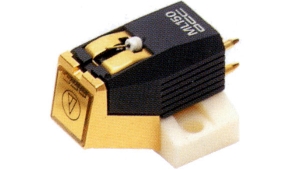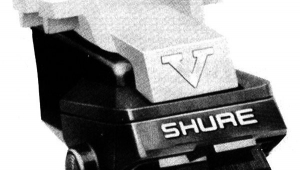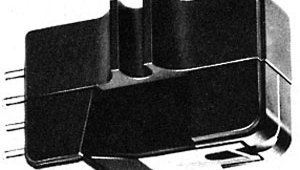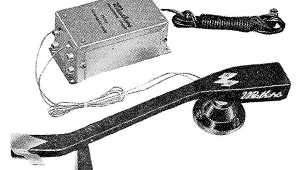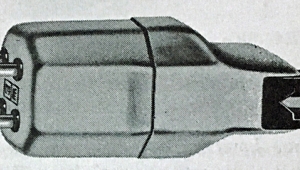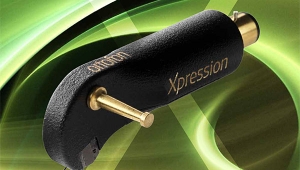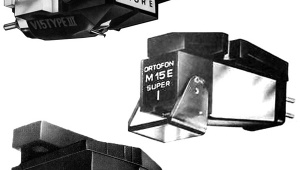| Columns Retired Columns & Blogs |
Brinkmann Pi phono cartridge
 The Brinkmann Pi cartridge's Benz-Micro heritage was obvious from the get-go. The motor is built to Brinkmann's specifications by Benz-Micro and includes a Micro-Ridge stylus. The cantilever material is not specified. The Pi's output is approximately 0.25mV, and its compliance is moderate at 15µm/mN. Recommended are a tracking force of 1.8–2gm, a VTA of 23°, and a resistive load of 600 ohms.
The Brinkmann Pi cartridge's Benz-Micro heritage was obvious from the get-go. The motor is built to Brinkmann's specifications by Benz-Micro and includes a Micro-Ridge stylus. The cantilever material is not specified. The Pi's output is approximately 0.25mV, and its compliance is moderate at 15µm/mN. Recommended are a tracking force of 1.8–2gm, a VTA of 23°, and a resistive load of 600 ohms.
Helmut Brinkmann says he tweaked the Pi's design for a year and a half before he achieved the results he desired, including making the tiny set screws out of various materials. The Pi, with a body of machined aluminum designed to control the dissipation of resonant energy, weighs a hefty 14gm. Brinkmann supplies aluminum screws and titanium washers, which, he claims, in combination with special damping between the cartridge body and headshell, have been "sonically tuned to create a unique musical instrument."
Sound
The Brinkmann Pi, mounted in the 9.6 tonearm and the Bardo turntable, produced superbly well-organized sound with clean, sharp attacks, reasonably strong sustain, and pronounced decay, all against a jet-black backdrop. The harmonic structures of instruments, while somewhat lean, were intact. Most Benz-Micro cartridges I've heard tend to sound somewhat polite and self-effacing on top; this combination's high-frequency production was anything but. Instead, it was well extended and slightly sharp in a pleasingly Teutonic way, if more pronounced than I like—at least in my system. The mids were smooth and clean, the bottom taut, well defined, and well extended: all in all, this was a good start for a "tight" front-end not yet broken in.
Raising the arm pillar about 5mm upped the SRA to a bit above 91°, which smoothed out the top end considerably and produced a more balanced sound that only improved as the Pi continued to break in. After that, as the suspension material settled over time, it was necessary to raise the pillar more to maintain 91°, or raise it to approximately 92°.
Digging into the essential reissue of The Nat King Cole Story (45rpm LPs, Capitol/Analogue Productions APP-SWCL 1613) brought nothing but pleasure: the warmish-sounding opening tracks had the proper mellow richness. (Though everything was rerecorded in stereo for this 1961 release, the earlier tunes were kept in the warm style of the mono originals, with minimal stereo separation.) Cole's creamy voice rides atop the sound of the somewhat softly recorded piano with the kind of clarity and definition that 1940s recordings couldn't produce. The Brinkmann combo did a very good job of capturing this, though it seemed a slight bit of edge remained on top that became more obvious as, in "Nature Boy," the producers maximized the stereo separation.
Switching to the equally remarkable Ella Fitzgerald Sings The Rodgers and Hart Song Book, Volume 1 (45rpm LPs, Verve/ORG 055), there was a bit more edge than I'd been used to from Fitzgerald's voice, and the huge kick-drum whomps in "You Took Advantage of Me," though deep, seemed robbed of the last bit of low-frequency extension and dynamic energy. Instrumental separation could have been more pronounced.
With the Pi cartridge riding in the massive Kuzma 4Point tonearm, the top end smoothed out considerably and was less pronounced without losing any air, transient speed, or high-frequency extension. Ella Fitzgerald's voice became more three-dimensional and nuanced and less bright, in part because the reverb better separated out into its own space instead of being submerged in the sound of her voice. The kick drum's energy produced a greater wallop and more satisfying whomp. More than that, the wind instruments in the right channel took on a richer, rounder harmonic sheen, while the piano in the left sported more wood and less cardboard. Images became more stable and solid—and through the 9.6 they'd already been plenty good in that regard.
Summing Up
The Brinkmann Pi cartridge strikes me as very competitive at and above its price of $2700, but its lack of a stylus guard could be problematic for those with cats or ham-handed domestic help. Its tonal balance was slightly on the lean side of neutral but only slightly so, and its overall extension at both frequency extremes was impressive, as was its tracking ability.
- Log in or register to post comments
